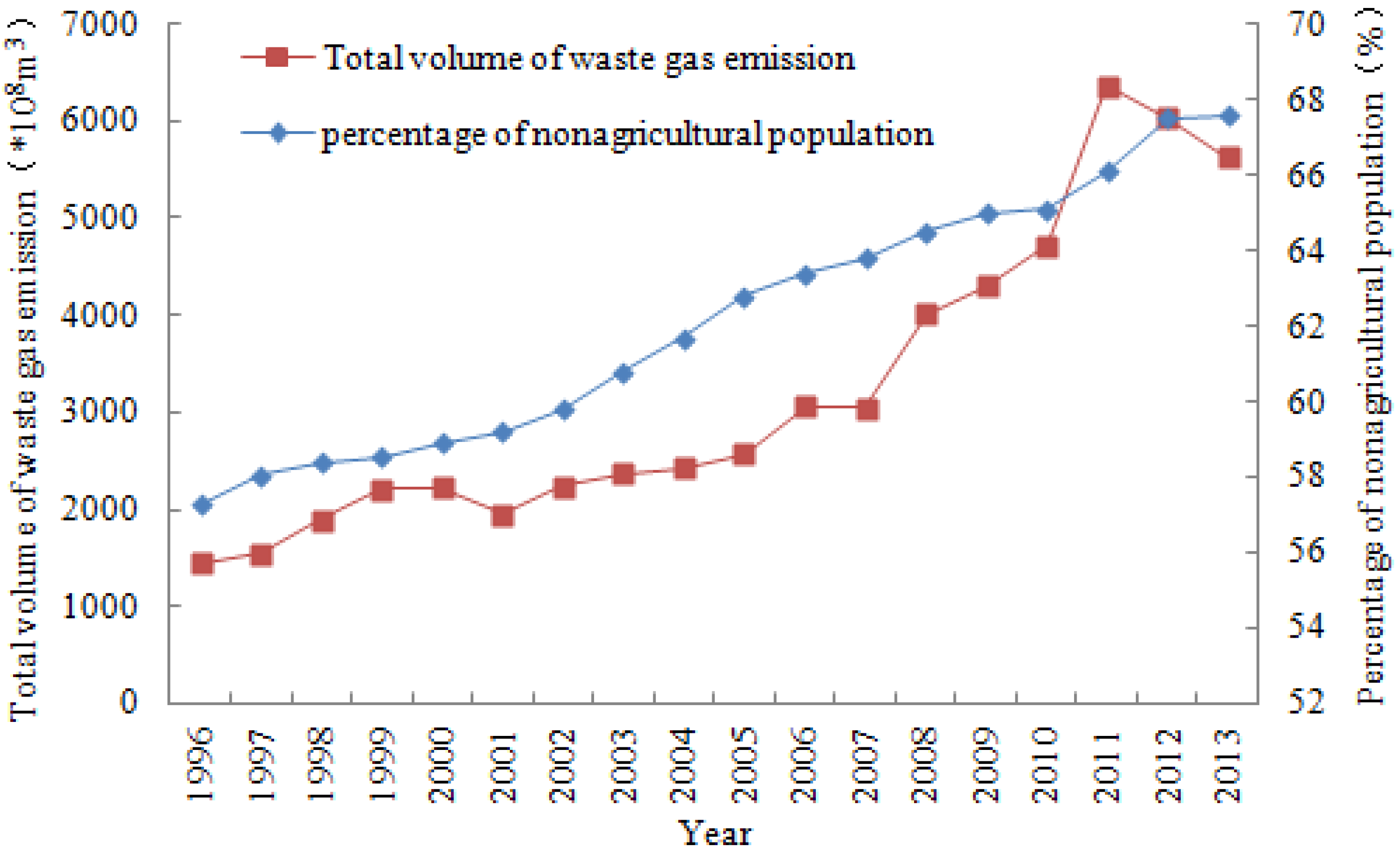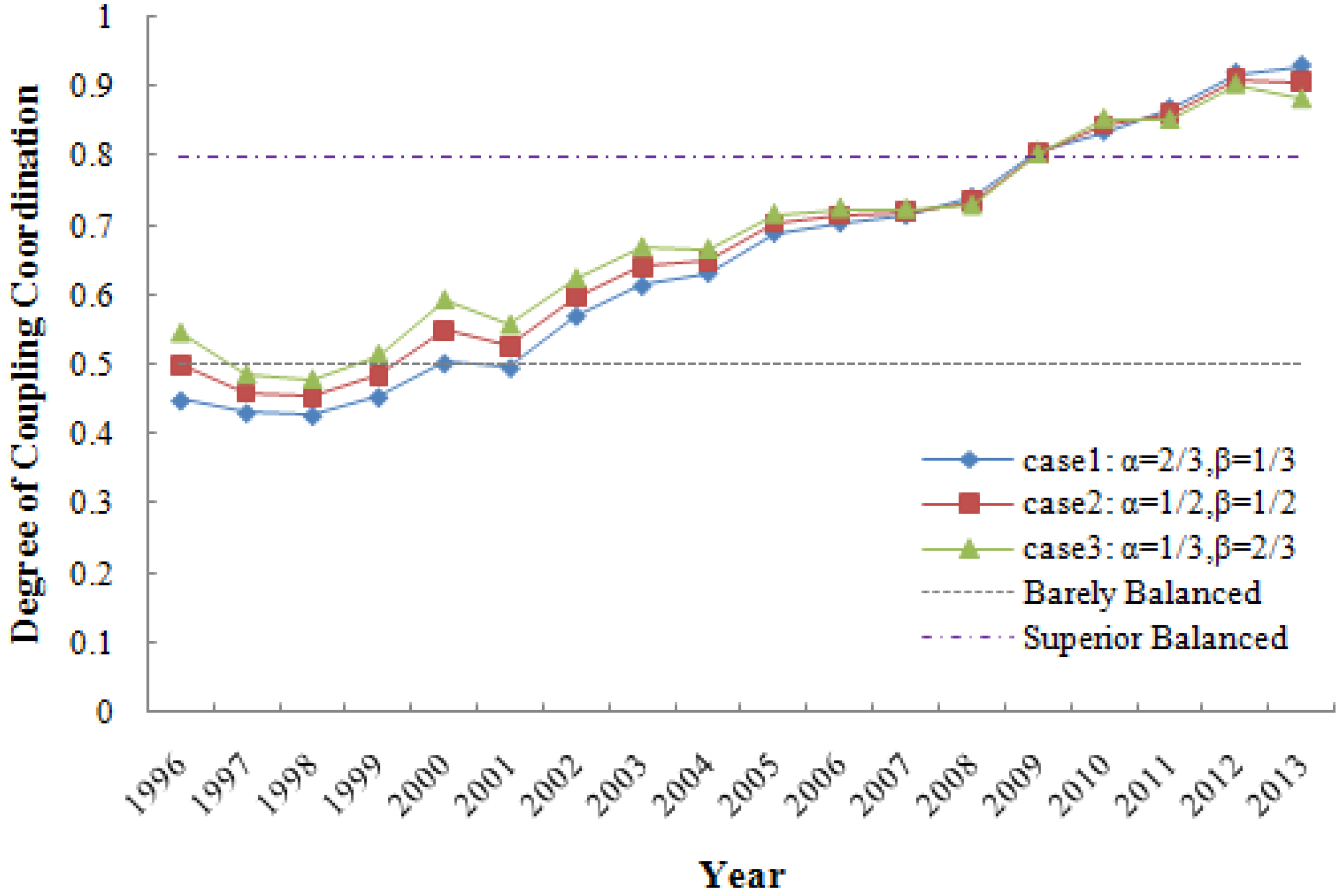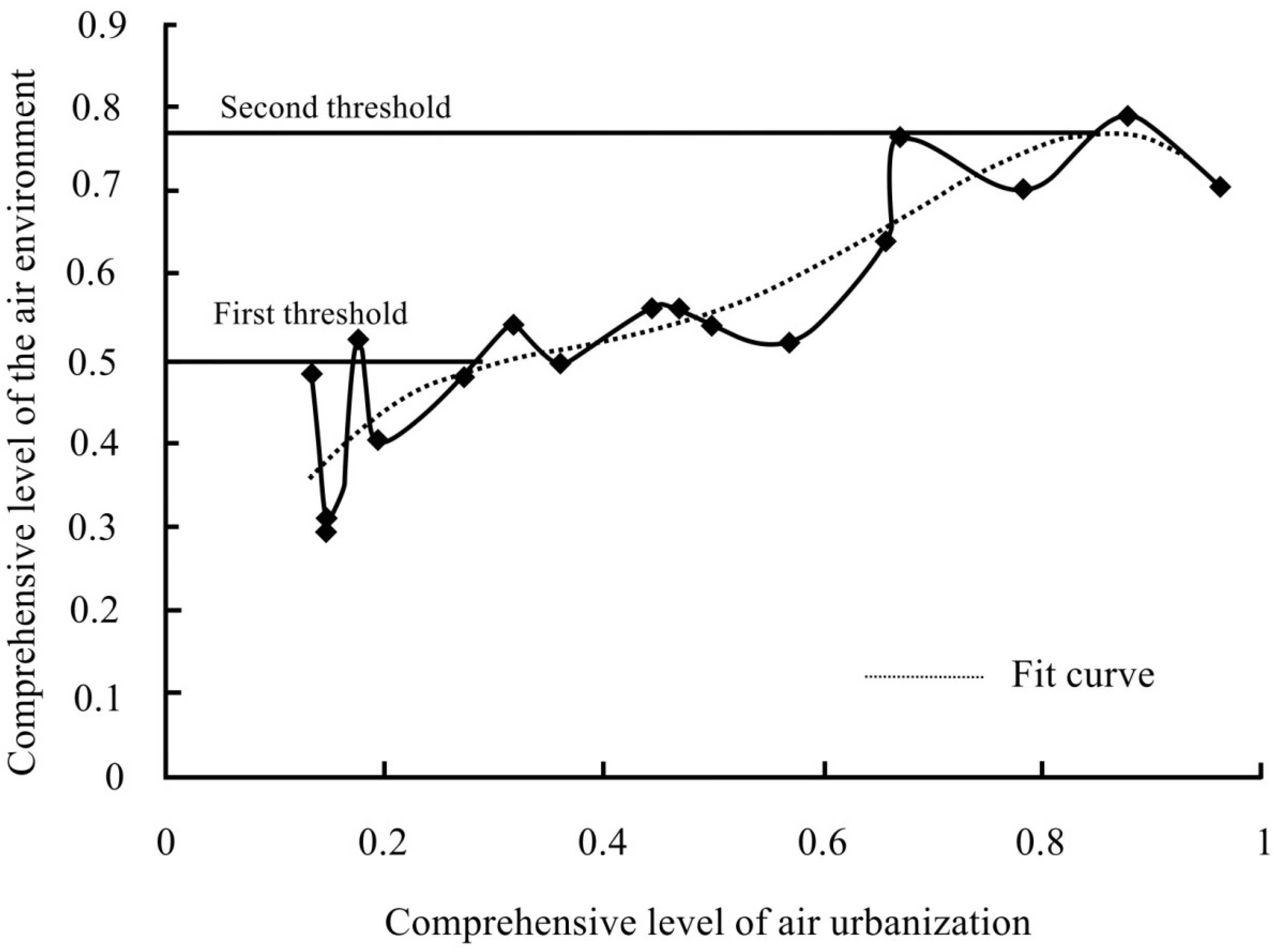Research on the Coupling Coordination Relationship between Urbanization and the Air Environment: A Case Study of the Area of Wuhan
Abstract
:1. Introduction
2. Materials and Methods
2.1. Study Area

2.2. Data Pre-Processing
2.3. Methods
2.3.1. Construct the Comprehensive Index System
| First Grade Indicators | wAHP | wMSD | AW1 | Basic Grade Indicators | wAHP | wMSD | AW2 | AW3 |
|---|---|---|---|---|---|---|---|---|
| Demographic urbanization | 0.338 | 0.200 | 0.269 | Percentage of nonagricultural population (%) | 0.345 | 0.251 | 0.298 | 0.080 |
| Urban population density (person/km2) | 0.180 | 0.247 | 0.214 | 0.058 | ||||
| Percentage of second industry employment (%) | 0.207 | 0.256 | 0.231 | 0.062 | ||||
| Percentage of tertiary industry employment (%) | 0.268 | 0.246 | 0.257 | 0.069 | ||||
| Spatial urbanization | 0.294 | 0.258 | 0.276 | Built-up area (km2) | 0.266 | 0.215 | 0.241 | 0.067 |
| Per capita area of roads (m2) | 0.180 | 0.195 | 0.188 | 0.052 | ||||
| Urban living space per capita (m2/person) | 0.249 | 0.210 | 0.229 | 0.063 | ||||
| Coverage rate of green area in built-up area (%) | 0.172 | 0.198 | 0.185 | 0.051 | ||||
| Park green area per capita (m2) | 0.133 | 0.182 | 0.157 | 0.043 | ||||
| Economic urbanization | 0.201 | 0.301 | 0.251 | GDP per capita (RMB) | 0.234 | 0.163 | 0.199 | 0.050 |
| Percentage of second industry in GDP (%) | 0.192 | 0.163 | 0.178 | 0.045 | ||||
| Gross value of industrial output (billion RMB) | 0.191 | 0.164 | 0.177 | 0.044 | ||||
| The Hoffman coefficient (%) | 0.181 | 0.168 | 0.175 | 0.044 | ||||
| Coal consumption(10 thousand tons) | 0.087 | 0.184 | 0.135 | 0.034 | ||||
| The unit GDP energy consumption (tons of standard coal per10 thousands RMB) | 0.115 | 0.158 | 0.136 | 0.034 | ||||
| Social urbanization | 0.167 | 0.241 | 0.204 | Urban per capita disposable income (RMB) | 0.258 | 0.204 | 0.231 | 0.047 |
| Per capita total retail sales of social consumer goods (Yuan) | 0.204 | 0.203 | 0.203 | 0.041 | ||||
| Numbers of running buses and taxis | 0.137 | 0.192 | 0.165 | 0.034 | ||||
| Private vehicle ownership | 0.193 | 0.204 | 0.198 | 0.040 | ||||
| Urban housing construction area (104 m2) | 0.208 | 0.198 | 0.203 | 0.041 |
| First Grade Indicators | wAHP | wMSD | AW1 | Basic Grade Indicators | wAHP | wMSD | AW2 | AW3 |
|---|---|---|---|---|---|---|---|---|
| Air Environmental Quality | 0.443 | 0.354 | 0.399 | Sulfur dioxide concentration (μg/m3) | 0.293 | 0.212 | 0.253 | 0.101 |
| Nitrogen dioxide concentration (μg/m3) | 0.227 | 0.238 | 0.232 | 0.093 | ||||
| PM10 concentration (μg/m3) | 0.325 | 0.279 | 0.302 | 0.120 | ||||
| Urban average fallout (ton/km2·month) | 0.155 | 0.271 | 0.213 | 0.085 | ||||
| Air Environmental Pressure | 0.329 | 0.395 | 0.362 | Total volume of waste gas emission (100 million cu. m) | 0.235 | 0.175 | 0.205 | 0.074 |
| Volume of soot emission (10,000 tons) | 0.194 | 0.159 | 0.177 | 0.064 | ||||
| Volume of industrial soot emission (10,000 tons) | 0.118 | 0.183 | 0.150 | 0.054 | ||||
| Volume of industrial dust emission (10,000 tons) | 0.111 | 0.179 | 0.145 | 0.052 | ||||
| Volume of sulfur dioxide emission (10,000 tons) | 0.207 | 0.153 | 0.180 | 0.065 | ||||
| Volume of industrial sulfur dioxide emission (10,000 tons) | 0.135 | 0.151 | 0.143 | 0.052 | ||||
| Air Environmental Control | 0.228 | 0.251 | 0.239 | Percentage of pollution treatment in GDP (%) | 0.161 | 0.206 | 0.184 | 0.044 |
| Industrial waste gas treatment facilities | 0.203 | 0.181 | 0.192 | 0.046 | ||||
| Percentage of industrial soot removed (%) | 0.201 | 0.189 | 0.195 | 0.047 | ||||
| Percentage of industrial dust removed (%) | 0.178 | 0.204 | 0.191 | 0.046 | ||||
| Percentage of industrial sulfur dioxide removed (%) | 0.257 | 0.220 | 0.238 | 0.057 |

2.3.2. Evaluation of the Indicators’ Weight
2.3.3. The Coupling Coordination Degree Model (CCDM)
| First Grade Index | Second Grade Index | Third Grade Index | Features | |
|---|---|---|---|---|
| Balanced Development (Acceptable Interval) | 0.8 < D ≤ 1.0 | Superior Balanced Development | g(E) − f(U) > 0.1 | Superiorly Balanced Development with Urbanization Lagged |
| f(U) − g(E) > 0.1 | Superiorly Balanced Development with Air Environment Lagged | |||
| 0 ≤ |f(U) − g(E)| ≤ 0.1 | Superiorly Balanced Development with Urbanization and Air Environment | |||
| Transitional Development (Transitional Interval) | 0.5 < D ≤ 0.8 | Barely Balanced Development | g(E) − f(U) > 0.1 | Barely Balanced Development with Urbanization Lagged |
| f(U) − g(E) > 0.1 | Barely Balanced Development with Air Environment Lagged | |||
| 0 ≤ |f(U) − g(E)| ≤ 0.1 | Barely Balanced Development with Urbanization and Air Environment | |||
| Unbalanced Development (Unacceptable Interval) | 0.3 < D ≤ 0.5 | Slightly Unbalanced Development | g(E) − f(U) > 0.1 | Slightly Unbalanced Development with Urbanization Hindered |
| f(U) − g(E) > 0.1 | Slightly Unbalanced Development with Hindered Air Environment | |||
| 0 ≤ |f(U) − g(E)| ≤ 0.1 | Slightly Unbalanced Development with Urbanization and Air Environment | |||
| 0 < D ≤ 0.3 | Seriously Unbalanced Development | g(E) − f(U) > 0.1 | Seriously Unbalanced Development with Urbanization Hindered | |
| f(U) − g(E) > 0.1 | Seriously Unbalanced Development with Air Environment Hindered | |||
| 0 ≤ |f(U) − g(E)| ≤ 0.1 | Seriously Unbalanced Development with Urbanization and Air Environment | |||
3. Results and Discussions
3.1. Variations of Comprehensive Urbanization and Air Environment Index
3.1.1. Variations of Comprehensive Urbanization

3.1.2. Variations of Comprehensive Level of Air Environment

3.2. Coupling Results of Comprehensive Urbanization (α) and the Air Environment (β)
| Year | Case1: α = 2/3, β = 1/3 | Case2: α = 1/2, β = 1/2 | Case3: α = 1/3, β = 2/3 |
|---|---|---|---|
| 1996 | Slightly Unbalanced Development with Urbanization Hindered | Barely Balanced Development with Urbanization Lagged | Barely Balanced Development with Urbanization Lagged |
| 1997 | Slightly Unbalanced Development with Urbanization Hindered | Slightly Unbalanced Development with Urbanization Hindered | |
| 1998 | |||
| 1999 | Barely Balanced Development with Urbanization Lagged | ||
| 2000 | Barely Balanced Development with Urbanization Lagged | Barely Balanced Development with Urbanization Lagged | |
| 2001 | Slightly Unbalanced Development with Urbanization Hindered | ||
| 2002 | Barely Balanced Development with Urbanization Lagged | ||
| 2003 | |||
| 2004 | |||
| 2005 | |||
| 2006 | Barely Balanced Development with Urbanization and Air Environment | Barely Balanced Development with Urbanization and Air Environment | Barely Balanced Development with Urbanization and Air Environment |
| 2007 | |||
| 2008 | |||
| 2009 | Superiorly Balanced Development with Urbanization and Air Environment | Superiorly Balanced Development with Urbanization and Air Environment | Superiorly Balanced Development with Urbanization and Air Environment |
| 2010 | |||
| 2011 | |||
| 2012 | |||
| 2013 | Superiorly Balanced Development with Air Environment Lagged | Superiorly Balanced Development with Air Environment Lagged | Superiorly Balanced Development with Air Environment Lagged |
 | |||

3.3. Fit Curve between Urbanization and Air Environment

4. Conclusions
Acknowledgments
Author Contributions
Conflicts of Interest
References
- Wang, S.J.; Fang, C.L.; Wang, Y. Quantitative investigation of the interactive coupling relationship between urbanization and eco-environment. Acta Ecol. Sin. 2015, 35, 2244–2254. (In Chinese) [Google Scholar]
- Luo, T.; Liu, Y.F.; Kong, X.S. System coupling between urbanization and eco-environment: Research progress in China. Trop. Geogr. 2014, 34, 266–274. (In Chinese) [Google Scholar]
- Wang, S.J.; Ma, H.T.; Zhao, Y.B. Exploring the relationship between urbanization and the eco-environment—A case study of Beijing-Tianjin-Hebei region. Ecol. Indic. 2014, 45, 171–183. [Google Scholar] [CrossRef]
- Yin, K.; Wang, R.S.; An, Q.X.; Yao, L.; Liang, J. Using eco-efficiency as an indicator for sustainable urban development: A case study of Chinese provincial capital cities. Ecol. Indic. 2014, 36, 665–671. [Google Scholar] [CrossRef]
- Wang, Z.B.; Fang, C.L.; Cheng, S.W. Evolution of coordination degree of eco-economic system and early-warning in the Yangtze River Delta. J. Geogr. Sci. 2013, 23, 147–162. [Google Scholar] [CrossRef]
- Wang, Q.S.; Yuan, X.L.; Ma, C.Y.; Zhang, Z.; Zuo, J. Researchon the impact assessment of urbanization on air environment with urban environmental entropy: A case study. Stoch. Environ. Res. Risk Assess. 2012, 26, 443–450. [Google Scholar] [CrossRef]
- Chen, R.J.; Wang, X.; Meng, X.; Hua, J.; Zhou, Z.J.; Chen, B.H.; Kan, H.D. Communicating air pollution-related health risks to the public: An application of the air quality health index in Shanghai, China. Environ. Int. 2013, 51, 168–173. [Google Scholar] [CrossRef] [PubMed]
- Xia, T.Y.; Wang, J.Y.; Song, K.; Da, L.J. Variations in air quality during rapid urbanization in Shanghai, China. Landsc. Ecol. Eng. 2014, 10, 181–190. [Google Scholar] [CrossRef]
- Luo, Y.P.; Chen, H.; Zhu, Q.A.; Peng, C.H.; Yang, G.; Yang, Y.Z.; Zhang, Y. Relationship between air pollutants and economic development of the provincial capital cities in China during the past decade. PLoS One 2014, 9, 1–14. [Google Scholar] [CrossRef] [PubMed]
- Xu, J.H.; Wang, X.S.; Zhang, S.Q. Risk-based air pollutants management at regional levels. Environ. Sci. Policy 2013, 25, 167–175. [Google Scholar] [CrossRef]
- Zhu, W.J.; Wang, J.Z.; Zhang, W.Y.; Sun, D.H. Short-term effects of air pollution on lower respiratory diseases and forecasting by the group method of data handling. Atmos. Environ. 2012, 51, 29–38. [Google Scholar] [CrossRef]
- Li, Y.F.; Li, Y.; Zhou, Y.; Shi, Y.L.; Zhu, X.D. Investigation of a coupling model of coordination between urbanization and the environment. J. Environ. Manage. 2012, 98, 127–133. [Google Scholar] [CrossRef] [PubMed]
- Grossman, G.M.; Krueger, A.B. Environmental Impacts of a North American Free Trade Agreement; MIT Press: Cambridge, MA, USA, 1991. [Google Scholar]
- Grossman, G.M.; Krueger, A.B. Economic growth and the environment. Q. J. Econ. 1995, 110, 353–378. [Google Scholar] [CrossRef]
- Shafik, N. Economic development and environmental quality: An econometric analysis. Oxford Econ. Pap. 1994, 46, 757–773. [Google Scholar]
- Selden, T.M.; Song, D. Environmental quality and development: Is there a Kuznets curve for air pollution Emissions? J. Environ. Econ. Manag. 1994, 27, 147–162. [Google Scholar] [CrossRef]
- Shaw, D.; Pang, A.; Lin, C.C.; Huang, M.F. Economic growth and air quality in China. Environ. Econ. Policy Stud. 2010, 12, 79–96. [Google Scholar] [CrossRef]
- Brajer, V.; Mead, R.W.; Xiao, F. Searching for an Environmental Kuznets Curve in China’s air pollution. China Econ. Rev. 2011, 22, 383–397. [Google Scholar] [CrossRef]
- Park, S.; Lee, Y.M. Regional model of EKC for air pollution: Evidence from the Republic of Korea. Energ. Policy 2011, 39, 5840–5849. [Google Scholar] [CrossRef]
- Al-Rawashdeh, R.; Jaradat, A.Q.; Al-Shboul, M. Air pollution and economic growth in MENA countries: Testing EKC hypothesis. Environ. Res. Eng. Manag. 2015, 70, 54–65. [Google Scholar] [CrossRef]
- Li, Q.; Song, J.P.; Zhang, J.H.; Yu, W.; Hu, H. Dynamics in the effect of China’s urbanization on air quality. Acta Sci. Circumst. 2013, 33, 2402–2411. (In Chinese) [Google Scholar]
- Wang, Q.S.; Yuan, X.L.; Lai, Y.H.; Ma, C.Y.; Ren, W. Research on interactive coupling mechanism and regularity between urbanization and atmospheric environment: A case study in Shandong Province, China. Stoch. Environ. Res. Risk Assess. 2012, 26, 887–898. [Google Scholar] [CrossRef]
- Han, L.J.; Zhou, W.Q.; Li, W.F.; Li, L. Impact of urbanization level on urban air quality: A case of fine particles (PM2.5) in Chinese cities. Environ. Pollut. 2014, 194, 163–170. [Google Scholar] [CrossRef] [PubMed]
- Cheng, Z.; Jiang, J.K.; Fajardo, O.; Wang, S.X.; Hao, J.M. Characteristics and health impacts of particulate matter pollution in China (2001–2011). Atmos. Environ. 2013, 65, 186–194. [Google Scholar] [CrossRef]
- Wu, D.; Fung, J.C.H.; Yao, T.; Lau, A.K.H. A study of control policy in the Pearl River Delta region by using the particulate matter source apportionment method. Atmos. Environ. 2013, 76, 147–161. [Google Scholar] [CrossRef]
- Zhong, L.J.; Louie, P.K.K.; Zheng, J.Y.; Yuan, Z.B.; Yue, D.L.; Ho, J.W.K.; Lau, A.K.H. Science-policy interplay: Air quality management in the Pearl River Delta region and Hong Kong. Atmos. Environ. 2013, 76, 3–10. [Google Scholar] [CrossRef]
- Wang, Q.S.; Yuan, X.L.; Zhang, J.; Mu, R.M.; Yang, H.C.; Ma, C.Y. Key evaluation framework for the impacts of urbanization on air environment: A case study. Ecol. Indic. 2013, 24, 266–272. [Google Scholar] [CrossRef]
- Zeng, C.; He, S.W.; Cui, J.X. A multi-level and multi-dimensional measuring on urban sprawl: A case study in Wuhan Metropolitan Area, Central China. Sustainability 2014, 6, 3571–3598. [Google Scholar] [CrossRef]
- Lu, S.S.; Guan, X.L.; He, C.; Zhang, J.L. Spatio-temporal patterns and policy implications of urban land expansion in metropolitan areas: A case study of Wuhan Urban Agglomeration, Central China. Sustainability 2014, 6, 4723–4748. [Google Scholar] [CrossRef]
- Ren, L.J.; Cui, E.Q.; Sun, H.Y. Temporal and spatial variations in the relationship between urbanization and water quality. Environ. Sci. Pollut. Res. 2014, 21, 13646–13655. [Google Scholar] [CrossRef] [PubMed]
- Guo, Y.T.; Wang, H.W.; Nijkamp, P.; Xu, J.G. Space-time indicators in interdependent urban-environmental systems: A study on the Huai River Basin in China. Habitat. Int. 2015, 45, 135–146. [Google Scholar] [CrossRef]
- Bao, C.; Fang, C.L. Water resources constraint force on urbanization in water deficient regions: A case study of the Hexi Corridor, arid area of NW China. Ecol. Econ. 2007, 62, 508–517. [Google Scholar] [CrossRef]
- Organization for Economic Cooperation and Development. Towards Sustainable Development: Environmental Indicators; OECD: Paris, France, 1998. [Google Scholar]
- Organization for Economic Cooperation and Development. Environmental Indicators for Agriculture; OECD: Paris, France, 1998. [Google Scholar]
- Liu, X.Z.; Heilig, G.K.; Chen, J.M.; Heino, M. Interactions between economic growth and environmental quality in Shenzhen, China’s first special economic zone. Ecol. Econ. 2007, 62, 559–570. [Google Scholar] [CrossRef]
- Fang, C.L.; Wang, J. A theoretical analysis of interactive coercing effects between urbanization and eco-environment. Chin. Geogr. Sci. 2013, 23, 147–162. [Google Scholar] [CrossRef]
- Ishizaka, A.; Labib, A. Review of the main developments of the analytic hierarchy process. Expert Syst. Appl. 2011, 39, 14336–14345. [Google Scholar] [CrossRef] [Green Version]
- Chen, Y.; Yu, J.; Khan, S. The spatial framework for weight sensitivity analysis in AHP-based multi-criteria decision making. Environ. Model. Softw. 2013, 48, 129–140. [Google Scholar] [CrossRef]
- Dai, Q.H.; Liu, G.B.; Liu, M.Y.; Wang, Y.B. An evaluation on sustainable development of eco-economic system in small watershed in hilly area of Northeast China. Acta Geogr. Sin. 2005, 60, 210–218. (In Chinese) [Google Scholar]
- Li, J.; Heap, A.D. A review of comparative studies of spatial interpolation methods in environmental sciences: Performance and impact factors. Ecol. Inform. 2011, 6, 228–241. [Google Scholar] [CrossRef]
- Cocklin, C.R. Methodological problems in evaluating sustainability. Environ. Conserv. 1989, 16, 27–32. [Google Scholar]
- Liu, Y.B.; Li, R.D.; Song, X.F. Analysis of coupling degrees of urbanization and ecological environment in China. J. Nat. Resour. 2005, 20, 105–112. (In Chinese) [Google Scholar]
- Yang, Q.; Ding, Y.; De Vries, B.; Han, Q.; Ma, H.M. Assessing regional sustainability using a model of coordinated development index: A case study of mainland China. Sustainability 2014, 6, 9282–9304. [Google Scholar] [CrossRef]
- Tang, Z. An integrated approach to evaluating the coupling coordination between tourism and the environment. Tour. Manag. 2015, 46, 11–19. [Google Scholar] [CrossRef]
- Liu, Y.B.; Li, R.D.; Li, C.H. Scenarios simulation of coupling system between urbanization and eco-environment in Jiangsu province based on system dynamics model. Chi. Geogr. Sci. 2005, 15, 219–226. [Google Scholar] [CrossRef]
- Tan, R.H.; Liu, Y.L.; Liu, Y.F.; He, Q.S.; Ming, L.C.; Tang, S.H. Urban growth and its determinants across the Wuhan urban agglomeration, Central China. Habitat. Int. 2014, 44, 268–281. [Google Scholar] [CrossRef]
- Zeng, C.; Cui, J.X.; Zhang, M.D.; Liu, B. The comparison of urban and rural built-up land change: A county-level investigation in Wuhan agglomeration. In Proceedings of the IEEE 22nd International Conference on Geoinformatics, Kaohsiung, Taiwan, 25–27 June 2014.
- Huang, H.; Dennis, W.Y. Intra-metropolitan location of foreign direct investment in Wuhan, China: Institution, urban structure, and accessibility. Appl. Geogr. 2014, 47, 78–88. [Google Scholar] [CrossRef]
- Liu, Y.Q.; Xu, J.P.; Luo, H.W. An integrated approach to modeling the Economy Society Ecology System in urbanization process. Sustainability 2014, 6, 1946–1972. [Google Scholar] [CrossRef]
- Li, L.; Qian, J.; Ou, C.Q.; Zhou, Y.X.; Guo, C.; Guo, Y.M. Spatial and temporal analysis of Air Pollution Index and its timescale-dependent relationship with meteorological factors in Guangzhou, China, 2001–2011. Environ. Pollut. 2014, 190, 75–81. [Google Scholar] [CrossRef] [PubMed]
© 2015 by the authors; licensee MDPI, Basel, Switzerland. This article is an open access article distributed under the terms and conditions of the Creative Commons Attribution license (http://creativecommons.org/licenses/by/4.0/).
Share and Cite
Ding, L.; Zhao, W.; Huang, Y.; Cheng, S.; Liu, C. Research on the Coupling Coordination Relationship between Urbanization and the Air Environment: A Case Study of the Area of Wuhan. Atmosphere 2015, 6, 1539-1558. https://doi.org/10.3390/atmos6101539
Ding L, Zhao W, Huang Y, Cheng S, Liu C. Research on the Coupling Coordination Relationship between Urbanization and the Air Environment: A Case Study of the Area of Wuhan. Atmosphere. 2015; 6(10):1539-1558. https://doi.org/10.3390/atmos6101539
Chicago/Turabian StyleDing, Lei, Weituo Zhao, Yalin Huang, Shenggao Cheng, and Chao Liu. 2015. "Research on the Coupling Coordination Relationship between Urbanization and the Air Environment: A Case Study of the Area of Wuhan" Atmosphere 6, no. 10: 1539-1558. https://doi.org/10.3390/atmos6101539






